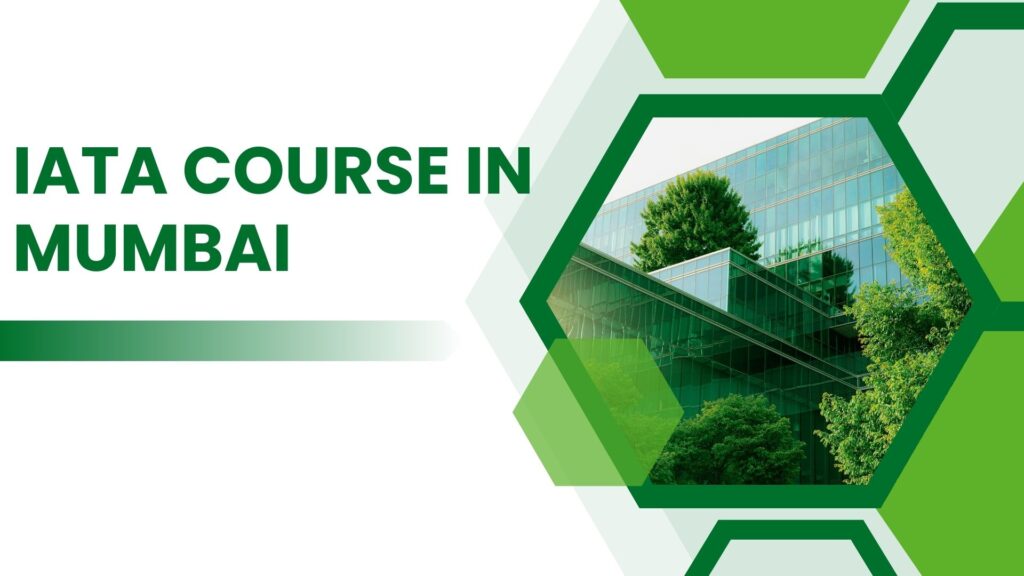Aviation Course in India

Table of Contents
- Introduction to Aviation Course in India
- Types of Aviation Courses
- Top Aviation Institutes in India
- Eligibility and Admission Process
- Course Structure and Duration
- Cost of Aviation Courses
- Career Opportunities After Aviation Course
- Salary Expectations in Aviation Industry
- Challenges in Aviation Careers
- Future of Aviation Industry in India
- FAQs About Aviation Courses

Image of post regarding course
Introduction to Aviation Course in India
The aviation industry in India is soaring at an unprecedented rate, making it one of the fastest-growing sectors in the world. As a result, the demand for skilled professionals has increased dramatically. For those aspiring to build a career among the clouds, enrolling in an Aviation Course is the first and most crucial step.
The aviation industry in India is booming, offering tremendous career opportunities for aspiring professionals. An aviation course in India provides comprehensive training in airline operations, airport management, air ticketing, and cabin crew management. These programs are designed to equip students with practical skills and industry knowledge, ensuring they are ready for exciting roles in airlines, airports, and travel companies across the globe.
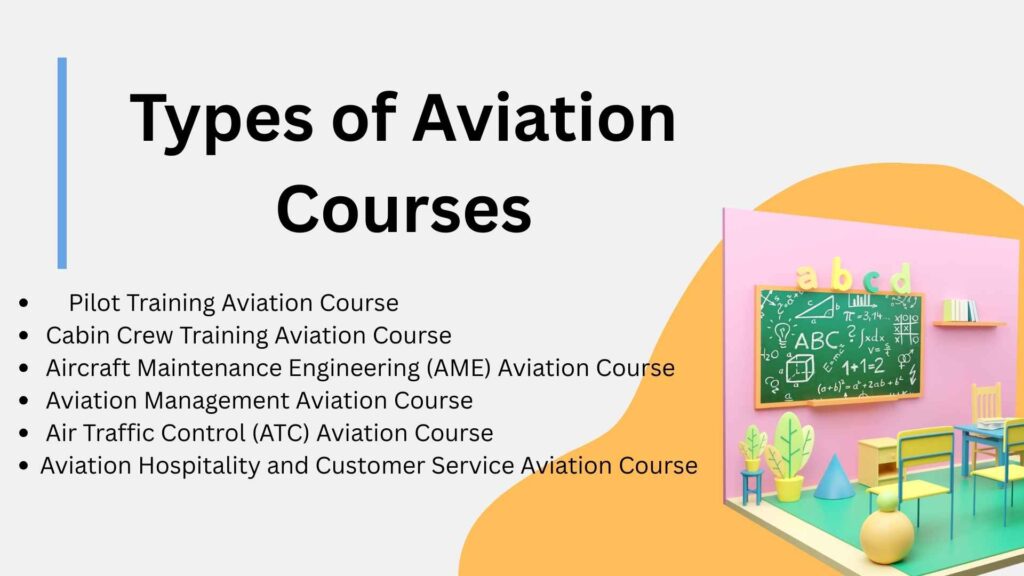
olffer image
Types of Aviation Courses
The aviation industry offers a wide range of courses to cater to different career interests and skill sets. Aviation courses are designed for individuals passionate about working in airlines, airports, or the aviation support sector. Some of the popular types of aviation courses include:
1. Pilot Training Courses
Pilot training programs prepare students to become commercial or private pilots. They cover areas like flight navigation, aviation regulations, and aircraft operations.
2. Cabin Crew and Air Hostess Training
These courses focus on customer service, in-flight safety, emergency procedures, and grooming standards, preparing students for careers as cabin crew members.
3. Airport Management Courses
Airport management programs teach students how to manage airport operations, logistics, safety regulations, and customer service effectively.
4. Aviation Maintenance Engineering
These technical courses train students in aircraft maintenance, repair, and overall engineering support to ensure aviation safety and performance.
5. Aviation Hospitality and Travel Management
These programs combine aviation, hospitality, and tourism training to prepare students for roles in airlines, travel agencies, and tourism companies.
Top Aviation Institutions in India
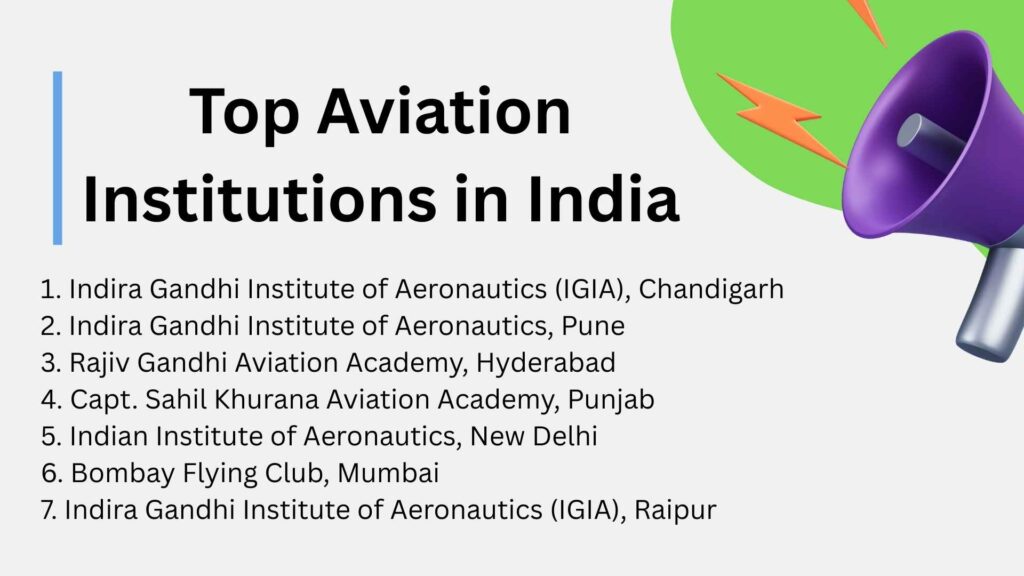
olffer image
Choosing the right institute is crucial when you are planning to pursue an Aviation Course. India is home to several prestigious institutions that offer world-class training and education in aviation. These institutions provide a variety of options that help students build a successful career in the booming aviation sector.
Here’s a look at some of the top aviation institutions offering the best programs in India:
1. Indira Gandhi Institute of Aeronautics (IGIA), Chandigarh
The Indira Gandhi Institute of Aeronautics is a top-rated school offering professional in this programs. It is well-known for its excellent pilot training programs, aviation management courses, and cabin crew certifications. Students from IGIA are placed in leading airlines across the globe.
2. Indira Gandhi Institute of Aeronautics, Pune
This institute is one of the finest for technical and commercial pilot training. They offer specialized structures like the Commercial Pilot License (CPL), Private Pilot License (PPL), and aviation safety courses. Their modern fleet and experienced instructors make it a preferred choice.
3. Rajiv Gandhi Aviation Academy, Hyderabad
The Rajiv Gandhi Aviation Academy is a premium training center providing a variety programs. Known for its advanced flight simulators and international training standards, the academy grooms students into industry-ready aviation professionals.
4. Capt. Sahil Khurana Aviation Academy, Punjab
Capt. Sahil Khurana Aviation Academy offers comprehensive options, including pilot training, cabin crew programs, and ground staff certifications. The academy focuses on personalized mentoring and high-quality hands-on training.
5. Indian Institute of Aeronautics, New Delhi
For students looking for a blend of technical and operational training, the Indian Institute of Aeronautics offers diverse modules. Specialties include Aircraft Maintenance Engineering (AME) courses, Pilot Training programs, and Aviation Management courses, providing a comprehensive foundation for a career in the aviation industry.
6. Bombay Flying Club, Mumbai
One of the oldest and most respected institutions, Bombay Flying Club provides world-class programs, especially for aspiring pilots. Their alumni include some of India’s best pilots and aviation leaders.
7. Indira Gandhi Institute of Aeronautics (IGIA), Raipur
Another branch of the prestigious IGIA, this institute offers various programs that meet the growing regional aviation demand. Courses here include pilot training, ground operations, and aviation hospitality training.
Eligibility and Admission Process
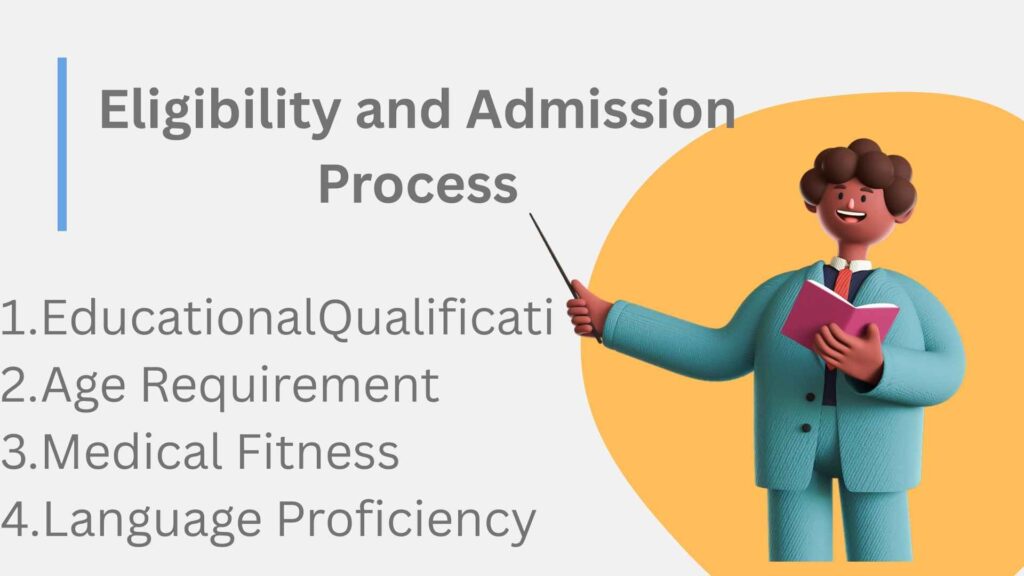
The aviation industry in India offers exciting career opportunities, but before stepping into this high-flying world, it is important to understand the eligibility requirements and admission process for Every specific criteria, ensuring that students are well-prepared for the challenges and responsibilities of the aviation field.
Educational Qualification:
Most Aviation Course programs require candidates to have completed their 10+2 education. For technical fields like Pilot Training and Aircraft Maintenance Engineering (AME), Physics and Mathematics are mandatory subjects.
Age Requirement:
The minimum age to apply for an Aviation Course is usually 17 or 18 years. Some institutes have specific age limits for certain programs like pilot training.Medical Fitness:
Physical and mental fitness is crucial in aviation. For a pilot training, candidates must pass a Class 2 or Class 1 Medical Examination approved by DGCA (Directorate General of Civil Aviation).Language Proficiency:
Good command of English is essential for most programs. Students must demonstrate their ability to read, write, and communicate effectively in English.
Course Structure and Duration in Aviation Courses
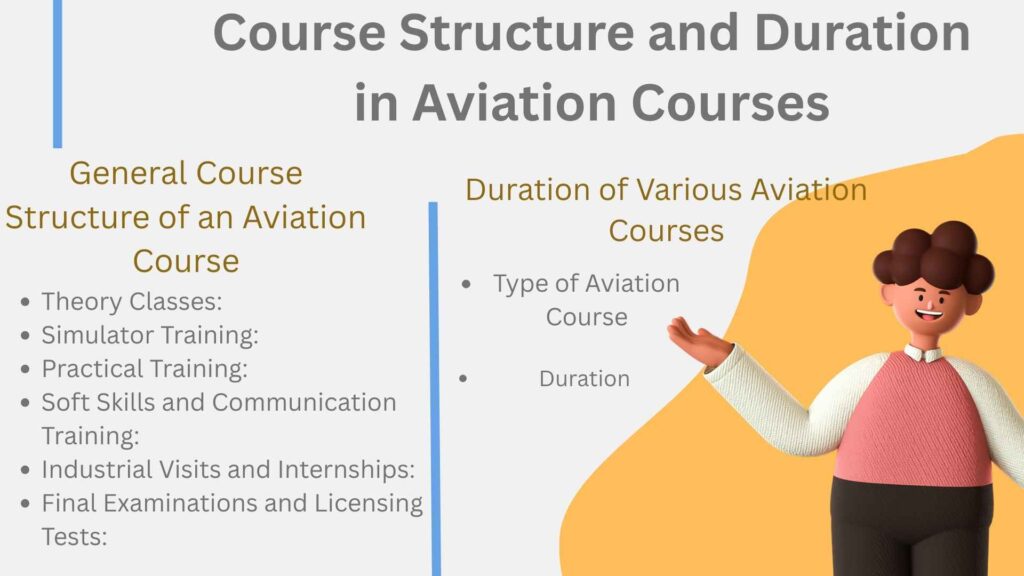
Understanding the course structure and duration is essential before enrolling. Each is designed carefully to equip students with the necessary theoretical knowledge and practical skills to excel in the aviation industry. Depending on the career path you choose — whether pilot training, aircraft maintenance, or aviation management — the course structure and duration
General Course Structure of an Aviation Course
An Aviation Course typically combines academic study, practical training, and internships. The structure is crafted to provide a balance between theoretical subjects and real-world experience.
Theory Classes:
Students are taught aviation basics, principles of flight, aircraft systems, meteorology, aviation regulations, and safety protocols.Simulator Training:
For pilot training and air traffic control programs, simulators are used to provide realistic flying or managing scenarios. Simulator sessions are a vital part of a technical.Practical Training:
Practical hands-on experience is an integral component. In a Pilot Training Course, students must log a required number of flight hours under instructor supervision. For Aircraft Maintenance courses, hands-on mechanical and electronic training is provided.Soft Skills and Communication Training:
Especially important for cabin crew and aviation management students, this module in focuses on grooming, interpersonal skills, and customer service.Industrial Visits and Internships:
Many institutes include mandatory internships at airports, airlines, or aviation companies as part of This gives students valuable industry exposure before they graduate.Final Examinations and Licensing Tests:
After completing coursework and practical hours, students often need to pass final exams or certification tests, such as DGCA licensing exams for pilots.
Duration of Various Aviation Courses
The duration of depends on the type of program and the level of certification or degree you pursue. Here’s an overview:
| Type of Aviation Course | Duration |
|---|---|
| Commercial Pilot License (CPL) Aviation Course | 18 to 24 months |
| Private Pilot License (PPL) Aviation Course | 6 to 12 months |
| Aircraft Maintenance Engineering (AME) Aviation Course | 2 to 3 years |
| Cabin Crew and Hospitality Aviation Course | 6 months to 1 year |
| Aviation Management Degree (BBA/ MBA) Aviation Course | 3 years (BBA) / 2 years (MBA) |
| Air Traffic Control (ATC) Aviation Course | 1 to 2 years |
| Aviation Safety and Security Aviation Course | 6 months to 1 year |
Modular Courses and Short-Term Certifications
Besides the long-term degrees and licenses, there are also short-term Aviation Course options available, such as:
Ground Staff Training: (Duration: 3 to 6 months)
Flight Dispatcher Certification: (Duration: 4 to 6 months)
Cabin Crew Refresher Courses: (Duration: 2 to 4 months)
These short programs are excellent for quick skill enhancement or career shifts within the aviation sector.
Cost of Aviation Course

One of the most important factors students consider before enrolling is the cost of an Aviation Course. Pursuing a professional can be a significant investment, but it opens doors to some of the most exciting and rewarding careers. The cost in India varies depending on the type of course, institution, location, and duration.
Average Cost of Various Aviation Courses in India
Here’s an overview of typical costs across different specializations:
| Type of Aviation Course | Average Cost Range (INR) |
|---|---|
| Commercial Pilot License (CPL) Aviation Course | ₹25 lakh – ₹50 lakh |
| Private Pilot License (PPL) Aviation Course | ₹6 lakh – ₹12 lakh |
| Aircraft Maintenance Engineering (AME) Aviation Course | ₹3 lakh – ₹7 lakh per year |
| Cabin Crew and Hospitality Aviation Course | ₹1 lakh – ₹3 lakh |
| Aviation Management Degree (BBA/ MBA) Aviation Course | ₹2 lakh – ₹5 lakh per year |
| Air Traffic Control (ATC) Aviation Course | ₹1 lakh – ₹2 lakh |
| Aviation Safety and Security Aviation Course | ₹80,000 – ₹2 lakh |
These costs are approximate and can vary based on the specific institute and the exact Aviation Course structure.
Career Opportunities After Aviation Course
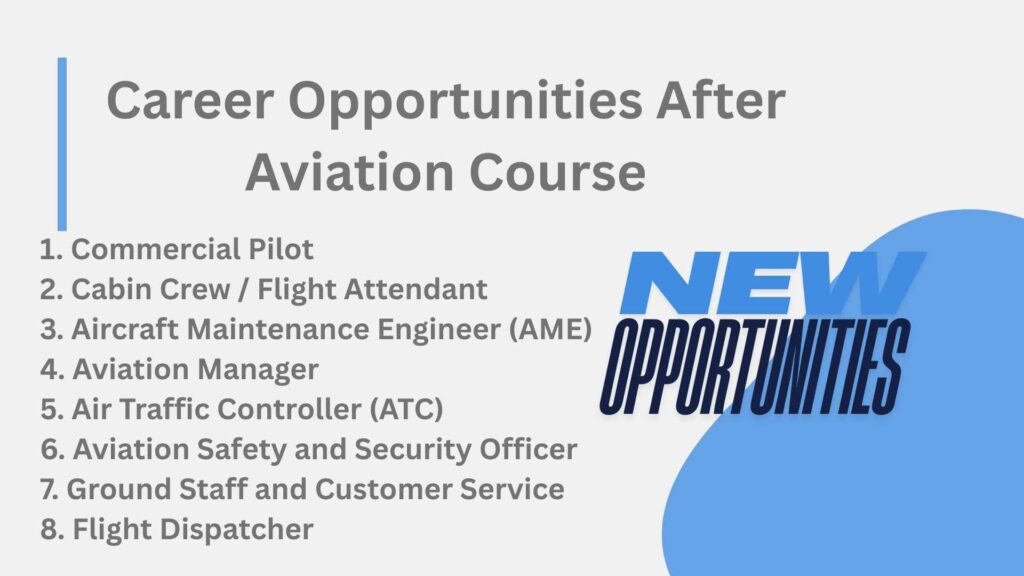
Completing an Aviation Course opens up a wide array of exciting career opportunities across different sectors of the aviation industry. The demand for skilled professionals is consistently rising as India becomes one of the fastest-growing aviation markets globally. With the right certification and training, you can secure prestigious, high-paying jobs in airlines, airports, cargo companies, and even private aviation firms.
Top Career Paths After an Aviation Course
1. Commercial Pilot
One of the most popular goals for students taking an Aviation Course is becoming a Commercial Pilot. After obtaining a Commercial Pilot License (CPL) through a certified, you can fly passenger airlines, cargo planes, or charter aircraft.
Key Highlights:
High earning potential
Opportunities to work with domestic and international airlines
Constant travel and dynamic work environment
2. Cabin Crew / Flight Attendant
Another highly sought-after role is Cabin Crew. Flight attendants ensure passenger safety, deliver excellent customer service, and manage onboard operations.
Key Highlights:
Glamorous lifestyle with international travel
Competitive salaries and benefits
Career progression into senior cabin crew or ground training roles
3. Aircraft Maintenance Engineer (AME)
Students who choose a technical program like Aircraft Maintenance Engineering can work as licensed AMEs, responsible for ensuring aircraft safety and airworthiness.
Key Highlights:
aviation course Critical technical role with high responsibility
Opportunities in airlines, MRO (Maintenance, Repair, Overhaul) organizations, and government aviation course sectors
4. Aviation Manager
Graduates focused on management can take up roles such as Airport Manager, Ground Handling Supervisor, or Airline Operations Manager.
Key Highlights:
Leadership roles managing airport operations, logistics, or airline services
Steady career growth with experience
aviation course Openings in both public and private aviation sectors
5. Air Traffic Controller (ATC)
Air Traffic Control leads to a high-responsibility career guiding aircraft during takeoff, landing, and en-route phases to ensure safe operations.
Key Highlights:
Government job with attractive pay scales
High level of technical training and specialization
Important role in maintaining airspace safety
6. Aviation Safety and Security Officer
Specialized programs train students to work in aviation safety and security roles, ensuring compliance with international safety standards and protecting airline assets.
Key Highlights:
Strong demand for safety officers in a growing aviation industry
Roles available at airports, cargo hubs, and airline companies
7. Ground Staff and Customer Service
Completing a hospitality-focused can land you roles in airport ground services, ticketing, baggage handling, and customer support.
Key Highlights:
Frontline roles interacting with passengers
Wide career scope across airlines, airport companies, and travel agencies
8. Flight Dispatcher
A Flight Dispatcher ensures flight plans are prepared efficiently, coordinating with pilots and ground staff. A specialized can prepare you for this critical operational role.
Key Highlights:
Strategic, behind-the-scenes position
Important for ensuring flight safety and on-time performance
Salary Expectations in Aviation Industry

One of the most exciting aspects of completing an the potential for excellent salary packages and career growth. The aviation industry is known for offering highly rewarding opportunities, both financially and professionally. After successfully completing on graduates can expect competitive salaries, various benefits, and clear pathways for promotion and global career prospects.
Salary Based on Career Path After Aviation Course
Different roles after completing come with varying salary structures. Here’s a detailed breakdown:
| Career Role | Starting Salary (INR per Month) | Experienced Salary (INR per Month) |
|---|---|---|
| Commercial Pilot (after Aviation Course) | ₹1.5 lakh – ₹4 lakh | ₹6 lakh – ₹10 lakh |
| Cabin Crew/Flight Attendant (after Aviation Course) | ₹30,000 – ₹75,000 | ₹1 lakh – ₹2 lakh |
| Aircraft Maintenance Engineer (AME) (after Aviation Course) | ₹40,000 – ₹1 lakh | ₹1.5 lakh – ₹3 lakh |
| Airport Manager (after Aviation Course) | ₹50,000 – ₹1 lakh | ₹2 lakh – ₹4 lakh |
| Air Traffic Controller (after Aviation Course) | ₹60,000 – ₹1 lakh | ₹2 lakh – ₹3 lakh |
| Aviation Safety Officer (after Aviation Course) | ₹40,000 – ₹80,000 | ₹1 lakh – ₹2 lakh |
| Ground Staff and Customer Service (after Aviation Course) | ₹25,000 – ₹50,000 | ₹60,000 – ₹90,000 |
| Flight Dispatcher (after Aviation Course) | ₹40,000 – ₹80,000 | ₹1 lakh – ₹2 lakh |
Challenges in Aviation Career
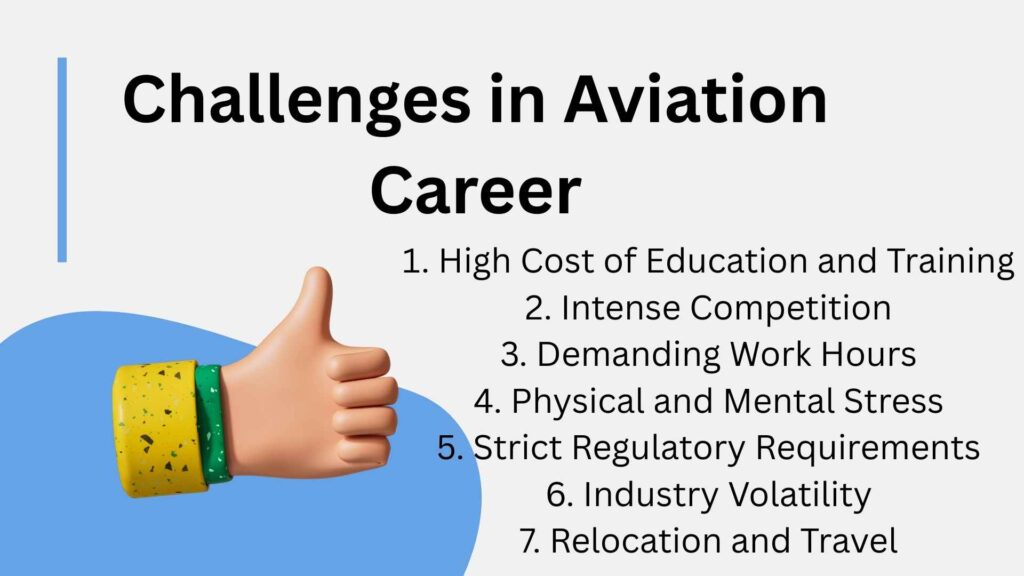
explore the main challenges aviation professionals face and how a strong Aviation Course foundation can help you overcome them.
1. High Cost of Education and Training
One of the first challenges is the significant financial investment required to complete a professional Whether you are training to become a pilot, aircraft engineer, or aviation manager, the fees can be high, and many students require financial planning or education loans to cover their costs.
2. Intense Competition
The aviation industry attracts thousands of students each year who complete with dreams of high-flying careers. However, the number of available positions, especially for pilots and cabin crew, can be limited compared to the number of applicants, leading to fierce competition.
3. Demanding Work Hours
A career after often involves irregular and long working hours. Pilots, flight attendants, and even ground staff must work night shifts, weekends, and holidays depending on flight schedules. Maintaining work-life balance can be challenging in the aviation world.
4. Physical and Mental Stress
Jobs in aviation are physically and mentally demanding. prepares you for the technical side, but real-world challenges like long-haul flights, jet lag, handling emergencies, and dealing with stressed passengers can add pressure. Mental resilience and physical fitness are essential for success.
5. Strict Regulatory Requirements
professionals must meet strict regulatory and licensing requirements. For example, pilots must pass regular medical checks, simulator tests, and license renewals. Similarly, engineers must comply with aviation safety standards. Non-compliance can affect your career progression.
6. Industry Volatility
The aviation industry is heavily influenced by external factors like fuel prices, economic downturns, global pandemics (as seen during COVID-19), and geopolitical tensions. These factors can lead to layoffs, salary cuts, or reduced hiring even if you have completed
7. Relocation and Travel
Many jobs after require you to relocate or constantly travel for work. For some, this is an exciting opportunity; for others, it can be challenging to stay away from family and friends for extended periods.
Future of Aviation Industry in India

1. Rising Air Passenger Traffic India is expected to become the third-largest aviation market in the world by 2030. Domestic air travel is growing rapidly, thanks to a rising middle class and affordable flight options. This boom translates into more demand for pilots, cabin crew, ground staff, and management professionals trained through an Aviation Course.
2. Government Initiatives and Investments
The Government of India’s policies, such as UDAN (Ude Desh ka Aam Nagrik), aim to make air travel affordable and widespread. Massive investments are being made in developing regional airports and improving aviation infrastructure. For students completing , this means a wider job market with opportunities across major cities and smaller towns.
3. Expansion of Airlines
Both existing airlines and new players are expanding their fleets and routes to cater to growing demand. Airlines like IndiGo, Air India, and Akasa Air are investing heavily in hiring talent, making it the perfect time to complete and enter the workforce.
4. Technological Advancements
The aviation sector is embracing cutting-edge technology like AI-based air traffic management, biometric boarding, and sustainable aviation fuel. Completing that includes technological training ensures that students are well-prepared for a futuristic, tech-driven aviation industry.
5. Global Opportunities
Indian-trained aviation professionals are in demand internationally. Completing an internationally recognized, opens doors to career opportunities not just in India but also across the Middle East, Europe, Australia, and North America.

![Cash Sales: Master Cash Sales in Tally Easily [2025 Guide]](https://earnready.com/wp-content/uploads/2025/04/ChatGPT-Image-Apr-28-2025-03_22_39-PM.webp)
